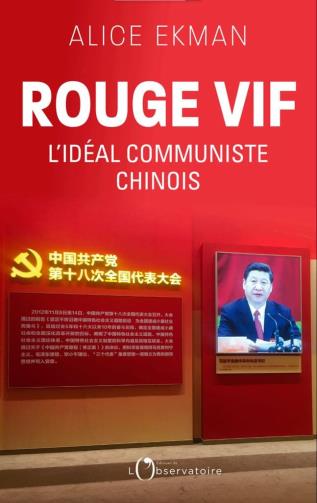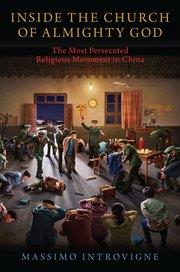
![]() Despite common perceptions that China remains communist only in name, the recent book Rouge Vif: L’Idéal Communiste Chinois (Paris: Editions de l’Observatoire), by Alice Ekman (European Union Institute for Security Studies), contends that—despite reforms and opening taking place after 1978—communist ideology continues to be a key component of the Chinese approach, and even more so after Xi Jinping took control. It is true that the current Chinese system is hybrid, mixing a variety of influences. However, not only does the Communist Party remain in control, but instruction in Marxism-Leninism has been reinforced at universities and more party cells
Despite common perceptions that China remains communist only in name, the recent book Rouge Vif: L’Idéal Communiste Chinois (Paris: Editions de l’Observatoire), by Alice Ekman (European Union Institute for Security Studies), contends that—despite reforms and opening taking place after 1978—communist ideology continues to be a key component of the Chinese approach, and even more so after Xi Jinping took control. It is true that the current Chinese system is hybrid, mixing a variety of influences. However, not only does the Communist Party remain in control, but instruction in Marxism-Leninism has been reinforced at universities and more party cells  have been established in private firms over recent years. One should not underestimate the lasting significance of ideological beliefs, writes Ekman in this well-documented book. Before examining the consequences of those realities for China and the world, Ekman provides an overview of the situation in ten chapters, each devoted to specific aspects that shows how communism and the control exercised by the Party with its 90 million members are still shaping Chinese society. One chapter of the book is devoted to religion, where Ekman finds that some level of tolerance exists—insofar the party can be in control of religious life and practice. Religious groups outside of official, State-controlled religious institutions are always at risk of being repressed or have their places of worship destroyed.
have been established in private firms over recent years. One should not underestimate the lasting significance of ideological beliefs, writes Ekman in this well-documented book. Before examining the consequences of those realities for China and the world, Ekman provides an overview of the situation in ten chapters, each devoted to specific aspects that shows how communism and the control exercised by the Party with its 90 million members are still shaping Chinese society. One chapter of the book is devoted to religion, where Ekman finds that some level of tolerance exists—insofar the party can be in control of religious life and practice. Religious groups outside of official, State-controlled religious institutions are always at risk of being repressed or have their places of worship destroyed.
Moreover, a policy of sinicization is being enforced, in order to cut out foreign influences in China. Religions are seen as potential counter-powers if they escape State control. Atheism remains a principle of the Communist Party, and it has become again more strongly affirmed in recent years that no Party member can belong at the same time to a religious organization, even if it is a legal one. Those who don’t comply are expelled from the party ranks. Interestingly, the Party may sometimes use of a quasi-religious vocabulary, speaking of the “Marxist faith” (something that goes back to Mao Zedong himself). Other concepts and terms are also borrowed from a religious vocabulary. Despite obvious limits in comparing a political organization with a religious one, Ekman sees the party as being analogous to a religious organization, with its doctrine, rituals, clothes, and moral principles. Communist fervor is far from dead in China, with young Party members sometimes being among the most enthusiastic and committed followers.
![]()
 Inside The Church of Almighty God (Oxford University Press, $29.95) by Massimo Introvigne, a specialist on new religious movements, provides interesting historical, and sociological insights about this controversial and fast-growing Chinese group, treating it within the framework of political and religious freedom in China. The church is based on un-orthodox Christian and end-times teachings, often criticizing the communist party, becoming the main target of China’s anti-religious policies. Introvigne bases his research on interviews with members, Chinese police, and anti-cult activists, and clearly sees China’s stance against the CAG, including its detaining and imprisonment of members, as representing the “new Falun Gong” in the level of hostility the communist party has against the group. The book argues that the Chinese government views the CAG as a dangerous competitor and subversive “cult” in society yet it has been consulting with scholars—including Introvigne himself—who are clearly critical of that view, suggesting some division in the communist party.
Inside The Church of Almighty God (Oxford University Press, $29.95) by Massimo Introvigne, a specialist on new religious movements, provides interesting historical, and sociological insights about this controversial and fast-growing Chinese group, treating it within the framework of political and religious freedom in China. The church is based on un-orthodox Christian and end-times teachings, often criticizing the communist party, becoming the main target of China’s anti-religious policies. Introvigne bases his research on interviews with members, Chinese police, and anti-cult activists, and clearly sees China’s stance against the CAG, including its detaining and imprisonment of members, as representing the “new Falun Gong” in the level of hostility the communist party has against the group. The book argues that the Chinese government views the CAG as a dangerous competitor and subversive “cult” in society yet it has been consulting with scholars—including Introvigne himself—who are clearly critical of that view, suggesting some division in the communist party.
But one result of viewing the CAG as an “evil cult” means that issues of religious and political freedom are off the table compared to less stigmatized groups. CAG has experienced fierce conflict with other Christian groups who also label them as a cult, often for their aggressive proselytization efforts, spreading what the author calls “fake news” about them on the Internet (includes an unsubstantiated murder). Introvigne finds that the persecution of CAG has led to members migrating around the world—a “globalization” that leaders now seen as divinely led. The rest of the book contains interesting accounts and small-scale surveys of Chinese members as well as non-Chinese converts, with Introvigne finding that the church is growing more through contacts on social media than the more usual kind of family networks that a new religion would draw on. In conclusion, Introvigne turns his legal acumen to the plight of CAG members from China who he finds are often unfairly treated by other countries in their application for refugee status.